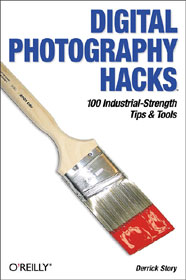 | ||||||
|
[ home | reviews | bylaws | library ]
View all our book reviews. Or, view our Software, hardware, and game reviews.
by Dale Fletcher
Whenever I get ready to purchase a book to learn more about a subject, I like to open the book and browse a little just to get a feel for how detailed the author has been (checking a subject that I am familiar with) and how easy it is for me to relate to the information as written (Checking a subject I am NOT familiar with). Digital Photography Hacks turned out to be pretty well written for a semi-techie book on "tricks of the photo trade" (referred to in the book as "Hacks"). The Author enlisted the help of several other digital photographers, gathering the best from each, to compile in this book. There are about 70 pure photo "Hacks" and then the others involve Phone Cams, Photoshop (or Elements), Accessories, and in some cases software or hardware for those with "unlimited budgets." Basically, a lot of good tips for most of us and a few for Hollywood. Derrick Story is not new to Digital photography or Photoshop. He has extensive experience with squeezing the most out of very little and having it look good. If you're new to photography in general, you may have to read a few of these twice. Those that came to digital from SLRs or moderate film cameras have probably tried and failed at many of these "hacks." Some of us have succeeded at these or similar hacks. But there are a few in the book that I've never tried, and many that are improvements on methods I've developed in the last thirty years of doing photography. There were at least a half dozen tricks that I just had to try right away, and all had merit. This book includes many color photos pictorially reinforcing the text and showing screen shots and hardware that might otherwise be difficult to understand, or at least, unclear. Also there are many useful URLs that are actually current. All the links I checked worked. Even some of the text was blue, which made this book a joy to navigate when used as a reference source. The index is clear and states what is covered in each of the "Hacks" so one can quickly locate a particular technique (Such as shooting Fireworks), and the associated equipment you might want to take with you to shoot for such an occasion. There are even a few QuickTime Pro directions in here to edit DigiCam movies and make scrolling titles. Who will benefit from this book? Anyone that has an interest in Digital Photography beyond the snapshot level. There are a lot of interesting experiments and techniques that are only practical since the innovation of digital photography (free film and immediate processing for all testing comes to mind). Night Photography, Motion, Infra Red, Bounce Flash, Multi Exposure, Time Lapse and Remote Photography are all introduced in a usable form. It might also be noted that Derrick shares my inability to remember things as accurately as we'd like, so the digital camera comes to the rescue in ways that just weren't practical with film. All told, the book comes out to about ten cents a page (297.2 content pages) or thirty cents per "Hack". If you only used 30% of the stuff, at a buck each, it's still not a bad investment for the quality of info inside. Like any Photoshop manual, the information will never get old. It gets added to, but rarely deleted. A good photo tip lasts forever, unlike a good Operating System.
View all our book reviews. Or, view our Software, hardware, and game reviews. [ home | newsletter | past | join | listserve | shareware | directory | links | md9 ] © 2004 by Dale Fletcher & MLMUG |
||||||

